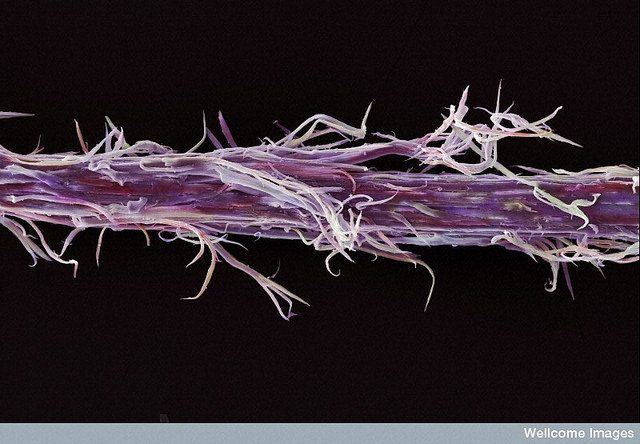X-rays show hair treatments don't penetrate or fix hair
| 23 Jan 2016But permanent waving does alter protein structure inside hair
Miracle products for fussy hair have probably been around longer than hair has even been studied. Though hair structure has now been investigated in great detail, with tools like X-ray diffraction and electron microscopy, hair repair products proliferate, and their benefits can be dubious at best. Beyond settling this cosmetic question, however, studying hair with imaging methods can be instructive for science — and health. Abnormally curly or twisted hair can actually be indicative of an underlying disease state; breast cancer, for example, can be accurately predicted using hair samples. Disease screening thus might benefit from hair imaging, but it’s only useful to study hair if the frequently used hair care products — shampoo, conditioner, and permanent waving treatments — don’t affect internal hair structure.
In an earlier study on hair structure, researchers sampled hair from a variety of individuals who used different amounts of shampoo and conditioner. In their new study, they wanted to study just one person’s hair, to discount any effects of differential product use.
Shampoos and conditioners have a whole host of ingredients, many of them completely unnecessary for their primary functions: cleaning and smoothing. Both products mainly interact with hair at the surface, or cuticle, level. Shampoo and conditioner will only reach the next layer, the cortex, if the cuticle is very damaged, in which case shampooing may contribute to even more hair damage. Repeated shampooing extracts more hair surface lipids (oils) while conditioning retains ingredients on the hair surface. Both products can affect the X-ray diffraction signal when the hair is imaged. Perming, for its part, also induces major structural changes in hair, breaking and re-forming chemical bonds within hair and making the hair surface more likely to shed lipids during shampooing.

False-color scanning electron micrograph of a bleached and straightened strand of hair. Image by Wellcome Images / CC BY-NC-ND 2.0
One female participant volunteered her hair to be shampooed, conditioned, and permed for this study. Roughly 400 strands of hair were divided between the eight different experimental treatments: with and without permanent waving, and with and without shampoo and conditioner (or both). Using a common drugstore shampoo and conditioner, the hair strands were bathed in petri dishes. Perming was done while the hair was still attached to the subject’s head. Hair strands were then clamped onto some cardboard and loaded into an X-ray diffractometer, which bombards the samples with X-rays to reveal structural properties at atomic and molecular scales of one ten-billionth of a meter.
Shampoo or conditioner alone or in combination had virtually no effect on the X-ray images obtained. This means it is likely that the hair’s internal lipid or keratin structure was not changed by shampooing or conditioning. The X-ray signal intensity of the permed hair samples suggests changes to the keratin filaments and how they are packed within the hair. Further, shampooing and conditioning had no “restorative” effect on the permed hair fibers.
This study is one more piece of evidence that shampoo and conditioner have only limited effects on the outermost hair layer, the cuticle, and do not alter the hair’s internal lipid or keratin structure. This means that researchers can usefully employ X-ray profiling to study keratin within hair (for disease screening, for example) without worrying about whether participants’ use of shampoo or conditioner will fundamentally affect the result — as long as the hair is not permed. Permed hair exhibited X-ray profiles consistent with broken bonds within the keratin microstructure. These X-ray data also support the idea that perming changes hair structure at the intermediate filament level (a half-way zone between protein complexes and the macro hair strand).
Citation:
Zhang, Y., Alsop, R. J., Soomro, A., Yang, F. C., & Rheinstädter, M. C. (2015). Effect of shampoo, conditioner and permanent waving on the molecular structure of human hair. PeerJ, 3, e1296. DOI: 10.7717/peerj.1296
